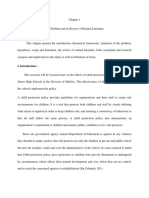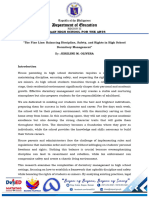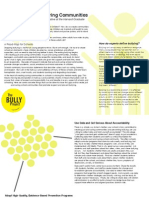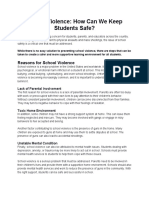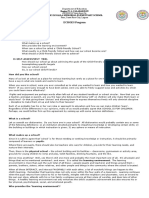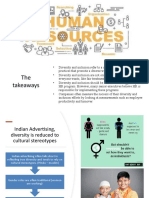The Duty Also Applies To Situations Both Before and After School Where A Teacher Can Be Deemed To Have Assumed' The Teacher Pupil Relationship
The Duty Also Applies To Situations Both Before and After School Where A Teacher Can Be Deemed To Have Assumed' The Teacher Pupil Relationship
Uploaded by
fevilyn limbagaCopyright:
Available Formats
The Duty Also Applies To Situations Both Before and After School Where A Teacher Can Be Deemed To Have Assumed' The Teacher Pupil Relationship
The Duty Also Applies To Situations Both Before and After School Where A Teacher Can Be Deemed To Have Assumed' The Teacher Pupil Relationship
Uploaded by
fevilyn limbagaOriginal Title
Copyright
Available Formats
Share this document
Did you find this document useful?
Is this content inappropriate?
Copyright:
Available Formats
The Duty Also Applies To Situations Both Before and After School Where A Teacher Can Be Deemed To Have Assumed' The Teacher Pupil Relationship
The Duty Also Applies To Situations Both Before and After School Where A Teacher Can Be Deemed To Have Assumed' The Teacher Pupil Relationship
Uploaded by
fevilyn limbagaCopyright:
Available Formats
Child
Safety and Health Policies (student)
The child protection policy describes the approach the school takes when it come
s to development of a healthy organization in which both children and young people feel
safe and secure. A school for children is not just a venue for formal education. Most
importantly, this is an institution which recognizes and respects children's rights and not
just their right to education. These rights also include their right to be protected, to be
able to play and play, to be protecting themselves from harm and violence and to freely
express their opinions and to be active in decision-making in accordance with their
changing capacities. A child-safety school also instills the obligations that go with its
rights in children while maintaining children's rights. They include respect for others'
rights, respect for diversity, fair practice and addressing disagreements without
violence. Equally critical is the development of a child-friendly school that encourages
children to learn as much as their academic capacities can take. It is a kind of
environment which allows you to grow healthy, provide you with knowledge and
information.
Care Duty Policy (teacher)
Besides their ethical responsibilities, teachers and administrators have a legal
duty to recognize and reasonable steps to protect students in their care. The teacher's
care responsibility is not limited to the school's locality or to school activities; or events
outside the school where a student acts on orders from an instructor. The duty also
applies to situations both before and after school where a teacher can be deemed to
have ‘assumed’ the teacher pupil relationship. While each case regarding a teacher’s
legal duty of care will be judged on the circumstances that occurred at the time, the
following common examples may be times when a teacher has failed to meet their legal
duty of care responsibilities to their students:- arriving late to scheduled timetabled
yard duty responsibilities failing to act appropriately to protect a student who claims to
be bullied believing that a child is being abused but failing to report the matter
appropriately being late to supervise the line up of students after the bell has sounded
leaving students unattended in the classroom or ignoring dangerous play failing to
instruct a student who is not wearing a hat to play in the shade leaving the school
during ‘non-face to face teaching time’ without approval inadequate supervision on a
school excursion
Policies of the Tribe Culture (local community)
A collaboration between parents and teachers, which aims to facilitate the
learning of the students and to improve the life of the students within the school is the
Parent Teacher Association. It is also a platform for parents to learn and to share their
views on the activities in their school. Official parent, teacher and staff association
designed to promote the involvement of the parents in the school. PTA’s are an active
part of educational life for schools throughout the world. Many thousands of parents’
volunteer in their child's school with PTA events to provide time and energies for
fundraising and to collaborate with school partners.
You might also like
- Usps Conditional Job Offer Letter CustodianDocument1 pageUsps Conditional Job Offer Letter CustodiansavvybagNo ratings yet
- Reproductive Coercion and Abuse ReportDocument24 pagesReproductive Coercion and Abuse ReportAlanna Vagianos50% (2)
- Child Protection PolicyDocument36 pagesChild Protection PolicyRoy ReyesNo ratings yet
- Chapter 1 ResearchDocument4 pagesChapter 1 ResearchGanelo JhazzmNo ratings yet
- AMERICAN JAZZ ROOTS GUMBO - Short EssayDocument3 pagesAMERICAN JAZZ ROOTS GUMBO - Short Essayjoseph ndung'uNo ratings yet
- The Concept of Child Friendly SchoolDocument23 pagesThe Concept of Child Friendly SchoolJussa Leilady AlberbaNo ratings yet
- The Concept of Child Friendly SchoolDocument6 pagesThe Concept of Child Friendly SchoolKrizna Dingding DotillosNo ratings yet
- Child Friendly SchoolsDocument10 pagesChild Friendly Schoolsquraishiomar001No ratings yet
- How Did You Like School?: A Self-Assessment Guide For A Child-Friendly SchoolDocument15 pagesHow Did You Like School?: A Self-Assessment Guide For A Child-Friendly SchoolElena PradoNo ratings yet
- Mackenzie Fries HDFS 301 Working With Minors Ethical DilemmasDocument12 pagesMackenzie Fries HDFS 301 Working With Minors Ethical Dilemmasapi-308037359No ratings yet
- Report in The Teaching ProfessionDocument7 pagesReport in The Teaching ProfessionDarleen Joy UdtujanNo ratings yet
- Sip Annex2ADocument14 pagesSip Annex2ARodel AgcaoiliNo ratings yet
- UmandaDocument6 pagesUmandaKavidi JayasekaraNo ratings yet
- Chapter 1 Research BUNDALIAN Re Bridget 2Document8 pagesChapter 1 Research BUNDALIAN Re Bridget 2MOOD SLAYERNo ratings yet
- Child Friendly School SurveyDocument27 pagesChild Friendly School SurveyWindel Beth Quimat ZafraNo ratings yet
- Safe Learning EnvironmentsDocument3 pagesSafe Learning Environmentswei chenNo ratings yet
- Disc Code 2012 EnglishDocument32 pagesDisc Code 2012 EnglishAli QureshiNo ratings yet
- DepEd Child Friendly schoolDocument6 pagesDepEd Child Friendly schoolruth topadoNo ratings yet
- Improvement Safe Schools Cap 5Document3 pagesImprovement Safe Schools Cap 5mirela_ema74No ratings yet
- Linglingay ES - CPP & School Rules and Regulations Handbook - Whole PageDocument32 pagesLinglingay ES - CPP & School Rules and Regulations Handbook - Whole PageJoy Karren DumaleNo ratings yet
- Annex 12 Child-Friendly School SurveyDocument14 pagesAnnex 12 Child-Friendly School SurveySheena Maye Porta100% (1)
- Child Friendly School - SY 2023 2024Document13 pagesChild Friendly School - SY 2023 2024Michael Eric NombrefiaNo ratings yet
- Moral and Legal Issues in EducationDocument9 pagesMoral and Legal Issues in Educationallannaryanadas100% (1)
- SIP Annex 2A Child Friendly School SurveyDocument16 pagesSIP Annex 2A Child Friendly School SurveyXthel AquinoNo ratings yet
- Child Protection and Anti-BullyingDocument9 pagesChild Protection and Anti-BullyingMar IlangosNo ratings yet
- Learning EnvironmentDocument5 pagesLearning Environmentwaniakhan2908No ratings yet
- How To Prevent Discrimination Against ChildrenDocument2 pagesHow To Prevent Discrimination Against ChildrenJohn Kennedy Pereda LactaotaoNo ratings yet
- 8656 Assignment No 1Document16 pages8656 Assignment No 1Muhammad SaleemNo ratings yet
- The Fine Line EditedDocument6 pagesThe Fine Line Editedjmo.byaheditoNo ratings yet
- Soci COMPONENT BDocument4 pagesSoci COMPONENT Bmukumbamufaro1No ratings yet
- Parents EssayDocument1 pageParents EssayJasher Dave AcabalNo ratings yet
- Treating Children With Respect and CareDocument4 pagesTreating Children With Respect and Carebishwabandhurokka49No ratings yet
- Ready For DefenseDocument52 pagesReady For Defenseapi-312376300No ratings yet
- Annex 2A Child Friendly School SurveyDocument13 pagesAnnex 2A Child Friendly School SurveyTuyom ES (Region VI - Negros Occidental)100% (1)
- Inclusive Education EssayDocument4 pagesInclusive Education EssayZechrist Zechariah50% (2)
- ENG1514 Assignment 03Document5 pagesENG1514 Assignment 03Siwe NhlapoNo ratings yet
- Bully Project InitiativeDocument4 pagesBully Project InitiativeAmir Kevin Al ShahraniNo ratings yet
- Advocacy-exampleDocument1 pageAdvocacy-exampleJhay GinesNo ratings yet
- School Violence - How Can We Keep Students SafeDocument2 pagesSchool Violence - How Can We Keep Students SafeTIRTHA DEB NATHNo ratings yet
- ECHOES Program: Department of EducationDocument9 pagesECHOES Program: Department of EducationRoberto FloresNo ratings yet
- Reflection About Child Protection PolicyDocument1 pageReflection About Child Protection PolicyJoy MolinoNo ratings yet
- Josefina Tan - PNHS -Children-At-Risk Incidents in School BasicDocument25 pagesJosefina Tan - PNHS -Children-At-Risk Incidents in School BasicJustified ByterenceeyrebelangoyNo ratings yet
- Professional Issue in Early Childhood Education - EditedDocument8 pagesProfessional Issue in Early Childhood Education - Editedsaleem razaNo ratings yet
- Child Protection PolicyDocument16 pagesChild Protection PolicykeiraNo ratings yet
- Child Protection PolicyDocument17 pagesChild Protection PolicykeiraNo ratings yet
- Local DiversityDocument1 pageLocal Diversityngannth1609No ratings yet
- Child Protection PolicyDocument16 pagesChild Protection PolicymistermayohNo ratings yet
- Supporting Students With Mental HealthDocument7 pagesSupporting Students With Mental Healthapi-744616976No ratings yet
- Inclusive EducationDocument2 pagesInclusive EducationTanvi Patil100% (1)
- Los Angeles Leadership Academy: My Lala, My LifeDocument8 pagesLos Angeles Leadership Academy: My Lala, My Lifeapi-319164396No ratings yet
- Child-Friendly School SurveyDocument15 pagesChild-Friendly School SurveyRichelle Paca-anasNo ratings yet
- Final Principles of TeachinggDocument9 pagesFinal Principles of TeachinggJalefaye Talledo AbapoNo ratings yet
- School Responsibilities & Duties of Students For Success in LifeDocument5 pagesSchool Responsibilities & Duties of Students For Success in LifeAstha MaheshwariNo ratings yet
- Interview With Dragi Zmijanac - Director of The First Children's Embassy in The World Megjashi Newspaper VEST, Saturday's Issue - May 7, 2016Document10 pagesInterview With Dragi Zmijanac - Director of The First Children's Embassy in The World Megjashi Newspaper VEST, Saturday's Issue - May 7, 2016FIRST CHILDREN'S EMBASSY IN THE WORLD MEGJASHI MACEDONIANo ratings yet
- Moreh Child ProtectionDocument6 pagesMoreh Child ProtectionPamela GalveNo ratings yet
- Supporting and Monitoring Student WelfareDocument11 pagesSupporting and Monitoring Student WelfareINformi William NgengeNo ratings yet
- Sip Annex 2a Child-Friendly School SurveyDocument12 pagesSip Annex 2a Child-Friendly School SurveyJulcon Avanceña Araiz100% (1)
- Empowering Parents & Teachers: How Parents and Teachers Can Develop Collaborative PartnershipsFrom EverandEmpowering Parents & Teachers: How Parents and Teachers Can Develop Collaborative PartnershipsNo ratings yet
- Passed 1678-13-21MELCS DepEd-CAR RO AdverbsDocument31 pagesPassed 1678-13-21MELCS DepEd-CAR RO Adverbsfevilyn limbaga100% (1)
- Leadership and ManagementDocument2 pagesLeadership and Managementfevilyn limbagaNo ratings yet
- Republic of The Philippines Department of Education Region VII, Central Visayas Division of Lapu-Lapu CityDocument5 pagesRepublic of The Philippines Department of Education Region VII, Central Visayas Division of Lapu-Lapu Cityfevilyn limbaga100% (1)
- Enrolment Report and AnalysisDocument1 pageEnrolment Report and Analysisfevilyn limbagaNo ratings yet
- Accomplishment Report: September 1-3, 2021Document1 pageAccomplishment Report: September 1-3, 2021fevilyn limbagaNo ratings yet
- Learning Activity SheetsDocument14 pagesLearning Activity Sheetsfevilyn limbaga100% (2)
- Session 3 Integrating Grammar Into A Skill-Based LessonDocument56 pagesSession 3 Integrating Grammar Into A Skill-Based Lessonfevilyn limbaga100% (3)
- Health: Quarter 1-Module 2Document29 pagesHealth: Quarter 1-Module 2fevilyn limbagaNo ratings yet
- Differentiated Instruction Strategies in The ClassroomDocument2 pagesDifferentiated Instruction Strategies in The Classroomfevilyn limbagaNo ratings yet
- Deped Activity SheetsDocument3 pagesDeped Activity Sheetsfevilyn limbagaNo ratings yet
- What Do You Consider To Be The Most Important Role of A School Administrator?Document2 pagesWhat Do You Consider To Be The Most Important Role of A School Administrator?fevilyn limbagaNo ratings yet
- Answerkey Sum - English 2Document1 pageAnswerkey Sum - English 2fevilyn limbagaNo ratings yet
- Testimonial Bandwagon Technical JargonDocument1 pageTestimonial Bandwagon Technical Jargonfevilyn limbagaNo ratings yet
- BALLOONDocument1 pageBALLOONfevilyn limbagaNo ratings yet
- The Rise of Neoliberal FeminismDocument21 pagesThe Rise of Neoliberal FeminismremiNo ratings yet
- Drug Use Among Young PeopleDocument16 pagesDrug Use Among Young Peoplelovebooks1980100% (1)
- Certificate Freedom Stationery Pty LTD BR11766 020822 1Document1 pageCertificate Freedom Stationery Pty LTD BR11766 020822 1digitaladcomediaNo ratings yet
- Amended ComplaintDocument9 pagesAmended ComplaintWDAM StaffNo ratings yet
- UNIT IV Intentional InjuriesDocument17 pagesUNIT IV Intentional InjuriesLiana Kay RevillozaNo ratings yet
- resoLUTION For Change SignatoriesDocument10 pagesresoLUTION For Change SignatoriesNawal AbdulgaforNo ratings yet
- Womb To TombDocument24 pagesWomb To TombNisha SomanathanNo ratings yet
- Changing Your SSNDocument5 pagesChanging Your SSNkhaos87No ratings yet
- The Addictive Nature of Video GamesDocument2 pagesThe Addictive Nature of Video GamesfontifantaNo ratings yet
- Dr. B.R. Ambedkar National Law University, Sonipat: Restorative JusticeDocument14 pagesDr. B.R. Ambedkar National Law University, Sonipat: Restorative JusticeNirmal KumarNo ratings yet
- Women's Safety in IndiaDocument28 pagesWomen's Safety in IndiaVicNo ratings yet
- USAPANG-EUT SIKLABSoroSoroDocument5 pagesUSAPANG-EUT SIKLABSoroSoroAsong, Daniel LorenzNo ratings yet
- Mandated Reporter Reflection en 421 GlazDocument3 pagesMandated Reporter Reflection en 421 Glazapi-509279793No ratings yet
- ACS - PPT - AditiDocument12 pagesACS - PPT - AditiAditi GaikwadNo ratings yet
- Overcoming Stigma Through Language A PrimerDocument15 pagesOvercoming Stigma Through Language A PrimerNisarg PatelNo ratings yet
- Gender Roles in Filipino CultureDocument3 pagesGender Roles in Filipino Culturedanielmangubat36No ratings yet
- Privacy LawsDocument11 pagesPrivacy LawsManoj SharmaNo ratings yet
- Crime Statistics in Naga City 2016-2018Document9 pagesCrime Statistics in Naga City 2016-2018Don Joev'sNo ratings yet
- Annotated BibliographyDocument12 pagesAnnotated Bibliographyapi-322388206No ratings yet
- Pride Month Proposa2Document8 pagesPride Month Proposa2Ghia PornillosNo ratings yet
- The Caste System in KeralaDocument5 pagesThe Caste System in KeralaKuriakose PariaramNo ratings yet
- 2-8 chc2d - The On To Ottawa TrekDocument3 pages2-8 chc2d - The On To Ottawa Trekapi-241505258No ratings yet
- SWOTDocument2 pagesSWOTJann Arville VillanuevaNo ratings yet
- Proposal Teen Age PregnancyDocument2 pagesProposal Teen Age Pregnancymountain girlNo ratings yet
- Acas Delivering Equality and Diversity (Nov 11) - Accessible-Version-Apr-2012Document40 pagesAcas Delivering Equality and Diversity (Nov 11) - Accessible-Version-Apr-2012kryshna18No ratings yet
- Anti Feminist Thesis StatementDocument6 pagesAnti Feminist Thesis StatementSarah Adams100% (2)
- Probation Law of The PhilippinesDocument5 pagesProbation Law of The PhilippinesSkier Mish0% (1)



